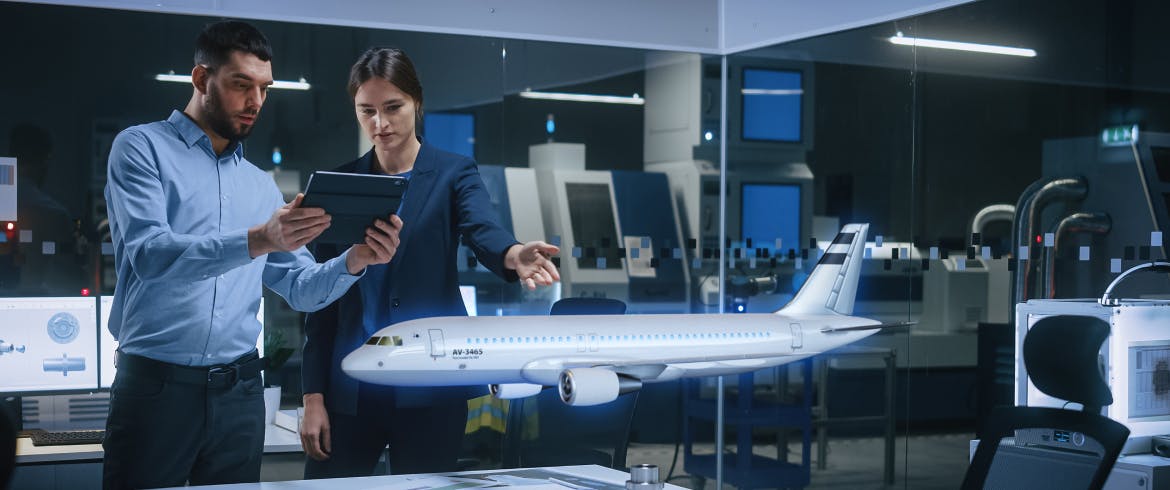
New Trends in the Aerospace Industry
We were recently asked by MRO Business Today, to share new trends in the aerospace industry. Here's where we see things heading.
1a. AI goes mainstream as the industry continues its push into digitalization
Artificial Intelligence (AI) is emerging as a tool to significantly improve operational performance. While the aerospace industry has historically lagged behind other industries when it comes to modernizing itself with new technologies, the application of AI provides new opportunities.
One of the biggest opportunities is to address the industry’s labor shortages, particularly in skilled areas such as parts sourcing and procurement, which significantly impact operational and economic performance. AI can assist purchasing teams and increase productivity by automating many of these processes by using AI to leverage structured data.
For example, by connecting the forecast with real-time market availability, one is able to adjust the planning and procurement to match the real needs of day-to-day operations. Currently using traditional methods, due to the complexity of the industry, and the constraints set by manual processes, an aircraft parts buyer is only able to process 10-20 purchases per day. AI helps to overcome these limitations by performing countless purchases in a matter of minutes, while also improving performance, achieving optimal pricing and delivery.
1b. Humans and machines learn to work together
Naturally, the next question regarding AI is, “will it take my job?” The answer is no, but it can significantly improve your job and get you ahead of your competition who is not using AI.
As a matter of fact, the organizations that will be most successful are those that manage to successfully marry together human ingenuity with artificial intelligence. It’s not a matter of human OR machine, but human AND machine. AI can help preprocess the vast amounts of data needed to make the correct purchasing decision while working with the buyer to “Curate” the outcomes to the optimal solutions.
AI turns human buyers into “super buyers” being able to process hundreds or thousands of part requirements in one go. While AI focuses on most purchases, human buyers can save time for the most complex issues and strategic tasks.
AI is a fantastic tool, but still needs human interaction to be most effective.
3. Airlines make moves to free up working capital
The airline industry runs on razor-thin margins, so every dollar counts. This is why airlines will continue to look for ways to free up cash and eliminate costs wherever possible.
One big problem is the amount of spare parts airlines stock. The excess inventory in the commercial aircraft market is estimated at around $50B.The amount of spares that airlines are stocking to support an aircraft and minimize downtime varies greatly from around ~$0.7M to $2.5M per aircraft.
Airlines will look to free up some of this cash in two ways:
- Matching the demand forecast regularly against market availability to adjust inventory planning and unlock working capital.
- Pooling parts together from which many airlines and MRO providers have access instead of each airline having to stock their parts.
Given the fleet size of medium and large airlines, even if a fraction of the amount of money spent on stock is freed up, it could result in a significant amount of extra capital.
4. Close collaborations and partnerships build a better ecosystem
As illustrated by the pooling example mentioned above, collaborations and partnerships can result in a better outcome for all parties involved.
Specifically looking at the aircraft supply chain, buyers, suppliers and OEMs need to band together to drive down costs and get the most out of existing inventory while identifying ways to fill holes in the supply. An example of how this can occur is by opening up data insights and sharing them with the market.
Right now, no one gets parts stocking right because they only see their own data, which creates excess and more costs. OEMs need to be supplied with data from airlines to improve the supply chain and lock in demand.
5. Sustainability Strides are made
One of the big goals of the industry is to become carbon neutral. A combination of travel demand rising, technology adoption soaring and consumer demand for more sustainable means of transportation will lead to the aerospace industry making tangible strides in sustainability.
By leveraging new technologies and better understanding data, airlines will become more efficient and less wasteful all the way from operations and maintenance to commercial functions and airside tasks.
Choose the service level you currently need and scale up and down as needed. You'll pay for everything your aircraft material procurement process needs and nothing it doesn’t – no risky contracts and frivolous add-ons.
